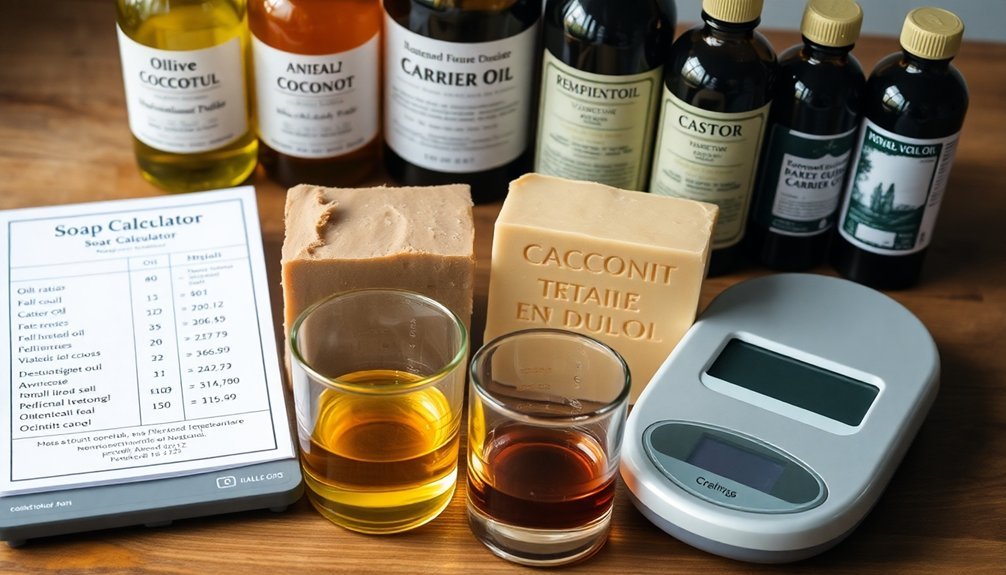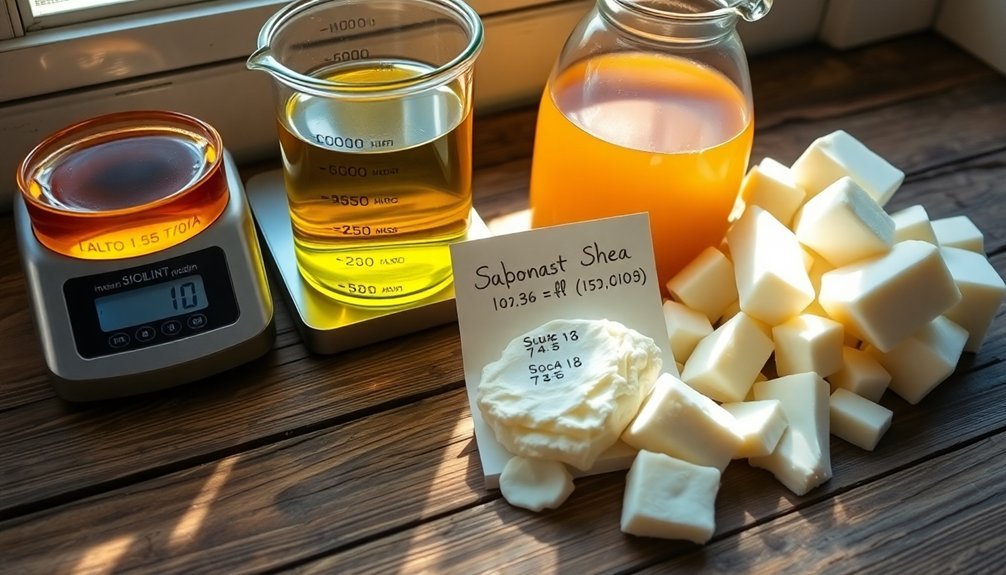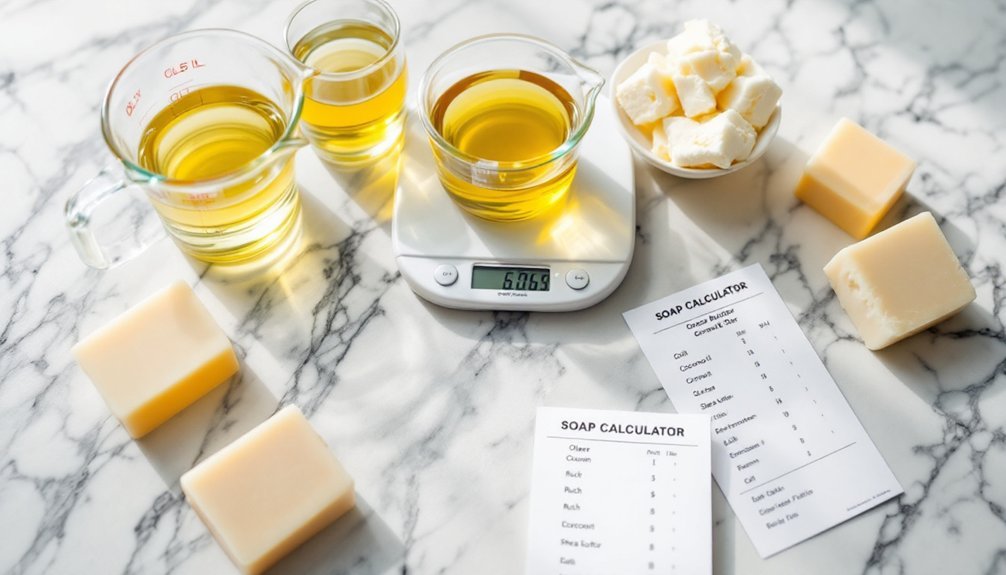For perfectly conditioned soap, aim for a 60:40 ratio of hard to soft oils. Start with 60-70% conditioning oils like olive or avocado as your base, add 20-30% cleansing oils like coconut, and incorporate 5-10% luxury oils such as argan or jojoba. Set your superfat percentage between 5-8% for balanced moisture retention. For sensitive skin, increase your olive oil content to 25-80% of the formula. The science behind these calculations reveals why some bars leave your skin silky smooth while others don't.
Calculate Perfect Soap Oil Ratios for Conditioning

When creating handmade soap, understanding the proper oil ratios can make the difference between a drying bar and a luxuriously conditioning one. Aim for a 60:40 hard to soft oil balance to achieve both structure and skin-nourishing benefits.
Start with conditioning oils like olive, avocado, or hemp as your base. Then add cleansing oils like coconut at moderate levels to avoid stripping the skin. Oils with low cleansing numbers tend to produce gentler bars that won't leave skin feeling tight or dry.
For maximum conditioning without sacrificing lather, incorporate 5-10% luxury oils such as argan or jojoba, and add 5-7% castor oil to stabilize bubbles.
Consider increasing your superfat percentage to 5-8% for extra moisturizing properties.
Don't forget that alternative liquids like goat's milk or aloe vera can enhance conditioning while maintaining a pH closer to your skin's natural level.
Understanding the Conditioning Scale in Soapmaking
The art of soapmaking goes beyond simply mixing oils and lye—it requires understanding how your ingredients affect the final product's properties.
One critical property is conditioning, which determines how moisturizing your soap will be for the skin.
In SoapCalc, the conditioning value represents your soap's ability to retain moisture. It's calculated by adding unsaturated fatty acids—oleic, linoleic, and linolenic—present in your oil blend.
For well-balanced soap, aim for a conditioning score between 44 and 69.
Oils like olive oil boost conditioning through their high unsaturated fatty acid content. Remember that not all fatty acids provide equal conditioning benefits, as linoleic acid contributes more conditioning properties than oleic acid.
You'll need to balance conditioning with other qualities like cleansing power and lather characteristics.
For dry skin formulations, prioritize higher conditioning values, while adjusting superfat levels can further enhance moisturizing properties without sacrificing other soap qualities.
Key Oils and Butters That Enhance Moisture Retention

When creating luxury conditioning blends for your soap, you'll want to select oils like olive, almond, and avocado that contribute exceptional moisture retention properties.
You should balance harder oils (coconut, palm) with softer conditioning oils (shea butter, olive oil) at appropriate ratios to create bars that cleanse effectively while maintaining skin hydration. For sensitive or aging skin, consider using olive oil at 25-80% of your formula as it provides very mild nourishment.
Adding a superfat percentage of 5-8% will leave behind free oils that aren't converted to soap, greatly boosting your soap's moisturizing abilities.
Luxury Conditioning Blends
Creating truly luxurious soaps requires careful selection of conditioning oils and butters that enhance moisture retention.
You'll want to incorporate oils rich in oleic and linoleic acids, such as olive and sunflower oils, as your base ingredients.
For premium conditioning, include 5-10% luxury oils like argan, flaxseed, or meadowfoam. A pre-made Luxury Shea Butter soap mix can simplify this process while ensuring consistent quality results.
These specialized oils greatly boost your soap's moisturizing properties and skin feel. Complement these with shea or cocoa butter to add creaminess and lock in hydration.
Consider increasing your superfat level to leave more unsaponified oils in the final product.
For an ultra-luxurious formula, try a blend of 30% olive oil, 20% coconut oil, and 10% shea butter, then enhance with humectants like honey or glycerin to elevate moisture retention even further.
Balance Hard/Soft Oils
Balancing hard and soft oils represents the foundation of successful soap formulation, directly impacting both the physical properties and conditioning qualities of your final product.
The standard 60% hard oils and 40% soft oils creates bars with ideal hardness while maintaining sufficient moisturizing properties.
When striking this balance, consider these essential guidelines:
- Use coconut oil (15-30%) for cleansing and lather, but don't exceed recommended percentages as it can be drying.
- Include olive oil (30-40%) for its exceptional conditioning properties that improve with cure time.
- Add specialty oils like shea butter (5-10%) for enhanced moisture retention.
- Incorporate castor oil (5-8%) to stabilize lather and boost conditioning effects.
Fine-tune these ratios based on your climate conditions and available ingredients, always keeping the need for both structure and skin nourishment in mind. Adding stearic acid should be carefully considered as it can cause rapid batter thickening when combined with other accelerating ingredients.
Superfat For Moisture
Superfatting your soap formulation stands as one of the most effective techniques for ensuring your bars deliver genuine skin hydration rather than just cleansing properties. This process leaves excess oils unsaponified, creating a protective barrier on your skin.
For maximum moisture retention, incorporate oils like olive, sweet almond, and castor oil. Olive oil's antioxidants provide exceptional conditioning, while castor oil contributes both moisture and rich lather.
Butters considerably enhance your soap's moisturizing capabilities. Consider shea butter for its emollient properties, cocoa butter for deep hydration, or mango butter (especially effective when added after saponification in hot process soap). Superfatted soaps are particularly beneficial for those with sensitive and dry skin, even helping manage conditions like eczema or psoriasis.
When calculating your superfat percentages, use a lye calculator to avoid miscalculations. Aim for 5-8% superfat for balanced moisture without risking DOS (Dreaded Orange Spots) or overly soft bars.
Balancing Hard vs. Soft Oils for Optimal Conditioning

The ideal soap requires a thoughtful balance between hard and soft oils to achieve proper conditioning without sacrificing structure.
Most balanced recipes use approximately 60% hard oils for firmness and lather, with 40% soft oils for moisturizing properties.
When formulating your recipe, consider these key factors:
- Hard oils (coconut, palm, cocoa butter) provide structure, cleansing, and abundant lather.
- Soft oils (olive, castor, avocado) deliver conditioning and moisturizing benefits.
- Too much hard oil creates bars that clean well but may dry skin.
- Too much soft oil produces moisturizing soap that's too soft to unmold easily.
Adjust your hard-to-soft oil ratio based on your specific needs—increase soft oils for more conditioning or hard oils for better lathering and firmness. Experimentation with different combinations is strongly encouraged to develop personalized recipes tailored to your preferences.
The Science Behind Superfat Percentages
When making soap, understanding the science of superfat percentages becomes essential for creating bars that properly nourish your skin without compromising quality. Superfatting involves deliberately leaving extra oils unsaponified to enhance moisturizing properties. Accurate measurements of your ingredients are critically important when calculating the proper superfat percentage for your soap.
| Superfat % | Effect | Risk | Best For |
|---|---|---|---|
| 0-3% | Cleansing, less moisturizing | May be drying | Oily skin, laundry soap |
| 5-7% | Balanced, standard | Minimal risks | All-purpose, beginners |
| 8-12% | More moisturizing | Softer bars, reduced lather | Dry skin, facial soap |
| 15-20%+ | Very conditioning | DOS risk, short shelf life | Coconut oil soaps, specialty products |
While 5% serves as a reliable starting point, you'll need to adjust based on your chosen oils. Coconut oil soaps often require higher superfatting (20-25%) to offset their potentially drying nature.
Calculating Oil Ratios for Dry and Sensitive Skin

Formulating soaps for dry and sensitive skin requires precise oil ratios that maximize conditioning properties while minimizing potential irritants.
Focus on high percentages of conditioning oils like olive oil (up to 70%) while carefully balancing cleansing oils such as coconut, which can be drying.
When crafting your recipe, consider these key ratios:
- Use 50-70% olive oil as your base for excellent conditioning
- Add 5-15% shea or cocoa butter for enhanced moisturizing
- Include 3-5% castor oil to support gentle lather
- Limit coconut oil to 15-20% to prevent over-drying
For sensitive skin, minimize additives and fragrances while incorporating gentle oils like sunflower (10-20%) or rice bran (up to 40%). Consider adding avocado oil at 5-10% as it provides exceptional benefits for dry and mature skin types.
Remember that proper oil ratios directly impact the soap's final conditioning properties and skin compatibility.
How to Formulate a Creamy Lather Without Sacrificing Moisture
Creating a luxuriously creamy lather without compromising moisture retention remains one of the greatest challenges for soap makers.
You'll find success by incorporating castor oil at 5-10% of your formula, as it enhances creaminess while maintaining conditioning properties.
Balance your recipe with the right combination of hard oils (palm, cocoa butter) and soft oils (olive, avocado).
Consider replacing water with milk or yogurt for added creaminess and moisture.
For enhanced lather stability without drying effects, add a teaspoon of sugar to your water phase.
Adjust your superfat percentage upward (typically 5-8%) to leave more unreacted oils in your finished soap.
Use a soap calculator like Soap Calc to fine-tune your formula, paying careful attention to both the lather and conditioning values to achieve the perfect balance.
Understanding the fatty acid profiles of your chosen oils will help you predict how your soap will perform and make informed substitutions when necessary.
Master Formulas: Proven Oil Combinations for Conditioning Soaps

You'll find exceptional conditioning by combining luxury oils like avocado and jojoba with moisture-rich butters such as shea or mango.
These oil pairings work synergistically to create soap that protects your skin's natural moisture barrier while delivering nourishment. Including castor oil at 5% will enhance lather while maintaining the conditioning properties of your formula.
For maximum conditioning, aim for a 60/40 balance of hard-to-soft oils, with 5-10% of your formula dedicated to specialty conditioning agents like meadowfoam or hemp oil.
Luxurious Oil Combinations
When crafting truly exceptional conditioning soaps, the perfect blend of oils makes all the difference between an ordinary bar and a luxurious bathing experience.
The most sumptuous combinations balance cleansing power with skin-nourishing properties. These formulations aim to deliver optimal fatty acid profiles for the mildest, most conditioning experience possible.
For your most decadent soaps, try these proven formulations:
- Olive-Avocado Luxury: 60% olive oil, 20% avocado oil, 15% coconut oil, 5% castor oil – creates a moisturizing bar with stable lather
- Silky Smooth Formula: 40% olive oil, 30% rice bran oil, 20% coconut oil, 10% cocoa butter – offers excellent conditioning with creamy lather
- Facial Bar Blend: 45% olive oil, 25% sunflower oil, 20% coconut oil, 10% jojoba oil – gentle cleansing with superior skin feel
- Mega-Moisture Bar: 50% olive oil, 20% almond oil, 20% coconut oil, 10% shea butter – ultra-conditioning with balanced cleansing
Butters for Lasting Moisture
Natural butters serve as the cornerstone of truly exceptional conditioning soaps, providing unmatched moisturizing properties that elevate your bars from merely cleansing to genuinely nourishing.
When formulating your recipes, incorporate shea butter at 10-15% for deep moisturization that won't compromise lather quality.
Cocoa butter, used at 5-10%, adds both hardness and luxury while infusing a subtle chocolate scent. For sensitive skin formulations, consider aloe or avocado butter at 5-8% of your total oils.
Mango butter works beautifully at 5-12%, creating firm bars with exceptional skin-softening benefits. For those seeking exotic options, Bramble Berry offers specialty butters like Turmeric Shea Butter and Coffee Butter that provide unique therapeutic properties.
For ideal results, pair these butters with complementary oils—shea works wonderfully with olive oil, while cocoa butter balances perfectly with sweet almond oil.
Adjust your superfat percentage to 7-10% when using butters for maximum conditioning benefit.
Adjusting Recipes for Seasonal Skin Changes
The changing seasons dramatically affect your skin's needs, requiring thoughtful adjustments to soap oil ratios throughout the year.
Winter demands higher oleic acid content from olive oil and increased superfatting to combat dryness, while summer skin benefits from lighter linoleic-rich oils like sunflower and safflower.
For ideal seasonal adjustments, focus on:
- Winter formulas: Increase oleic-rich oils (olive, avocado) and superfat percentage to 8-10%
- Summer blends: Shift to lighter oils with higher linoleic content and reduce superfat to 5-7%
- Spring changes: Add 3-10% castor oil for stable lather without drying effects
- Fall preparations: Balance fatty acid profiles as skin sensitivity fluctuates
Remember that humidity levels considerably impact your skin's moisture needs, so adjust accordingly when moving between dry and humid environments. Consider using nourishing shea butter as it helps harden soap while providing exceptional moisturizing properties for transitional weather.
Testing and Refining Your Conditioning Formulations
Start with small test batches of your soap formulations to save ingredients while experimenting with different oil ratios.
Keep a detailed journal where you track every change to your recipes, including precise measurements and your observations about the resulting soap's conditioning properties.
You'll quickly identify which oil combinations create the most moisturizing bars by methodically testing and documenting your results.
Implementing pH strip tests will help ensure your conditioning soap bars are properly balanced and safe for consumers.
Testing Small Batches
Experimentation sits at the heart of developing effective conditioning soap formulations. Before scaling up production, you'll need to validate your oil ratios through methodical testing of small batches, analyzing both the process and final product.
Begin with these essential testing approaches:
- pH strip testing to confirm complete saponification (ideal range: 8-10)
- Moisture content analysis to verify proper curing and shelf stability
- Performance assessment of lather quality and rinseability
- Skin compatibility testing on small areas before full application
Document your results meticulously, noting how adjustments to oil ratios affect the final product.
Iterative testing allows you to refine your formulation while minimizing waste of ingredients.
Remember that superfatting levels greatly impact conditioning properties—increase gradually until you achieve your desired moisturizing effect.
Track Formula Changes
Systematic tracking of formula changes serves as the cornerstone of successful soap formulation development. Create a detailed log documenting every modification you make to your recipes, including oil ratios, superfat percentages, and additive amounts.
Note how each adjustment affects trace time, hardness, and especially conditioning properties.
When testing oil substitutions, remember that most oils aren't directly interchangeable—except for palm and tallow—due to different saponification values. Recalculate your lye amounts using a soap calculator like SoapCalc with each ingredient change.
Record both objective measurements and subjective experiences from testing. Does increasing olive oil content improve moisturizing? How does raising your superfat from 5% to 7% affect skin feel?
These insights will guide your iterations, helping you balance cleansing power with conditioning benefits until you achieve your perfect formula.
Cost-Effective Substitutions for Luxury Conditioning Oils
Why spend a fortune on specialty oils when numerous affordable alternatives offer comparable benefits?
You'll find excellent substitutes that maintain your soap's luxurious feel without breaking the bank.
Jojoba oil mimics luxury oil consistency, while grapeseed provides lightweight moisture for oily skin types.
For those seeking rich moisturizing properties, avocado oil delivers premium benefits at a more accessible price point than fancy alternatives.
Consider these budget-friendly carrier oil swaps:
- Replace expensive nut oils with sunflower oil for vitamin E benefits
- Substitute babassu for coconut oil in solid-at-room-temperature applications
- Use canola instead of olive oil for everyday formulations
- Try fractionated coconut oil instead of pricier liquid carriers
Experiment with these alternatives while tracking formula changes to maintain your soap's conditioning properties.
Frequently Asked Questions
Can Soap Be Over-Conditioned and Become Ineffective at Cleaning?
Yes, you'll find that overly-conditioned soap contains excessive moisturizing agents that interfere with its surfactant action. This creates a film that prevents proper cleaning and leaves residue on surfaces you're trying to clean.
How Do Ph Levels Affect a Soap's Conditioning Properties?
Higher pH soaps (more alkaline) strip natural oils, reducing conditioning. You'll find soaps with pH closer to your skin's natural level (5.5) are gentler but may clean less effectively. Balance is key.
Does Water Temperature While Washing Impact Conditioning Benefits?
Yes, water temperature affects conditioning benefits. You'll get better results using lukewarm water (around 100°F) for washing, then rinsing with cool water to close cuticles and lock in moisture from conditioners.
Will Adding Honey Enhance Conditioning Properties in Soap?
Yes, adding honey will enhance your soap's conditioning properties. It's a natural humectant that draws moisture into your skin, providing deep hydration, improving texture, and strengthening your skin's protective barrier while soothing irritation.
Can Conditioning Soaps Still Produce Good Lather for Shaving?
Yes, conditioning soaps can still produce excellent lather for shaving. You'll find properly formulated ones balance moisturizing ingredients with lathering agents, giving you both the rich cushion for your razor and skin-nourishing benefits.
In Summary
You've learned how to balance oil ratios for perfect conditioning in your handmade soaps. By understanding conditioning values, selecting moisture-rich oils, and adjusting your superfat percentages, you'll create bars that nourish skin without sacrificing hardness or lather. Don't be afraid to experiment with seasonal adjustments and cost-effective substitutions. Remember, your perfect formula combines science with personal preference—keep testing until you've created your signature conditioning soap.





Leave a Reply